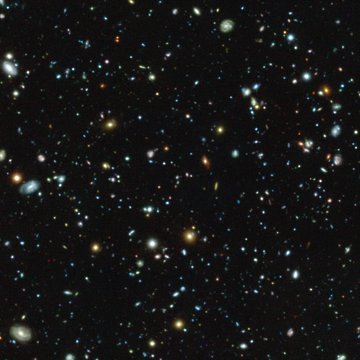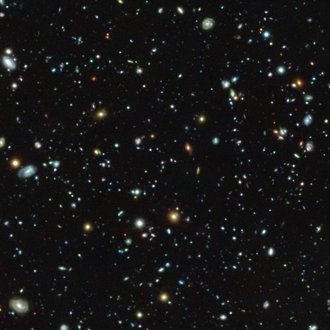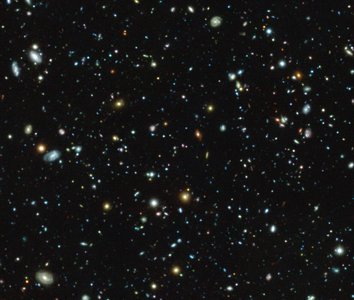MUSE most detailed look at galaxy field

Colour image of the Hubble Ultra Deep Field region observed with the MUSE instrument on ESO’s Very Large Telescope. The picture only gives a very partial view of the MUSE data, which also provide a spectrum for each pixel in the picture.
Credit: ESO/MUSE HUDF collaborationAstronomers using the MUSE instrument on ESO’s Very Large Telescope in Chile focused on the Hubble Ultra Deep Field, measuring distances and properties of 1600 very faint galaxies including 72 galaxies that have never been detected before. This resulted in the deepest spectroscopic observations ever made and 10 science papers that are being published in a special issue of Astronomy & Astrophysics.
"The MUSE data enabled for the first time a systematic investigation of the motions of stars in galaxies in the early Universe. Our results show that regular stellar motions, typical of the star-forming galaxies in the present-day Universe, were already in place about 6 billion years ago,” explains Davor Krajnović, researcher at the Leibniz Institute for Astrophysics Potsdam (AIP) and one of the authors of the now published papers describing results from this survey.
The survey team observed a much-studied patch of the southern constellation of Fornax, the Hubble Ultra Deep Field (HUDF). Precise spectroscopic information was measured for ten times as many galaxies as have been detected in this field over the last decade by ground-based telescopes. The original HUDF images were pioneering deep-field observations with the NASA/ESA Hubble Space Telescope published in 2004. Now, despite the depth of the Hubble observations, MUSE has — among many other results — revealed 72 galaxies never seen before in this very tiny area of the sky. The MUSE data provides a new view of dim, very distant galaxies, seen near the beginning of the Universe. It has detected galaxies 100 times fainter than in previous surveys, adding to an already richly observed field and deepening our understanding of galaxies across the ages.
“With MUSE we discovered lots of extremely faint and small galaxies, in fact many more than were previously expected, and the combined ultraviolet radiation from these ultrafaint galaxies plays an important role in shaping the universe as we know it,” says MUSE programme scientist Lutz Wisotzki.
The survey unearthed 72 galaxies known as Lyman-alpha emitters that shine only in Lyman-alpha light, the brightest line emitted by hydrogen gas. Because MUSE disperses the light into its component colours these objects become apparent, but they remain invisible in deep direct images such as those from Hubble. Another major finding of this study was the systematic detection of luminous hydrogen halos around galaxies in the early Universe, giving astronomers a new and promising way to study how material flows in and out of early galaxies.
Many other potential applications of this dataset are explored in the series of papers, and they include studying the role of faint galaxies during cosmic reionisation (starting just 380 000 years after the Big Bang), galaxy merger rates when the Universe was young, galactic winds, star formation as well as mapping the motions of stars in the early Universe.
MUSE is an integral-field spectrograph in operation at the Very Large Telescope (VLT) of the European Southern Observatory (ESO). The overall lead of the project is at the Observatoire de Lyon (CRAL) and at ESO. MUSE covers the visible to near-infrared region and can simultaneously record thousands of spectra of entire regions on the sky and reconstruct images from this data. MUSE is one of the most successful and requested instruments at the VLT. The MUSE collaboration takes advantage of its Guaranteed Time Observing (GTO). AIP members of the MUSE-GTO team include Andreas Kelz, Josephine Kerutt, Davor Krajnović, Martin Roth, Rikke Saust, Kasper Schmidt, Ole Streicher, Matthias Steinmetz, Tanya Urrutia, Peter Weilbacher, and Lutz Wisotzki.
"Several people at AIP were involved at various levels in the now published studies. The spectroscopic survey was one of the prime reasons for building MUSE. The AIP contribution was crucial, from building the instrument, developing the data reduction pipeline, to the scientific work published in the papers,” concludes Davor Krajnović.
Further information
MUSE HUDF Special Issue in A&A:
www.aanda.org/component/toc/?task=topic&id=868
More information about MUSE:
Original press release, images, and videos by ESO:
https://www.eso.org/public/news/eso1738/

Colour image of the Hubble Ultra Deep Field region observed with the MUSE instrument on ESO’s Very Large Telescope. The picture only gives a very partial view of the MUSE data, which also provide a spectrum for each pixel in the picture.
Credit: ESO/MUSE HUDF collaborationAstronomers using the MUSE instrument on ESO’s Very Large Telescope in Chile focused on the Hubble Ultra Deep Field, measuring distances and properties of 1600 very faint galaxies including 72 galaxies that have never been detected before. This resulted in the deepest spectroscopic observations ever made and 10 science papers that are being published in a special issue of Astronomy & Astrophysics.
"The MUSE data enabled for the first time a systematic investigation of the motions of stars in galaxies in the early Universe. Our results show that regular stellar motions, typical of the star-forming galaxies in the present-day Universe, were already in place about 6 billion years ago,” explains Davor Krajnović, researcher at the Leibniz Institute for Astrophysics Potsdam (AIP) and one of the authors of the now published papers describing results from this survey.
The survey team observed a much-studied patch of the southern constellation of Fornax, the Hubble Ultra Deep Field (HUDF). Precise spectroscopic information was measured for ten times as many galaxies as have been detected in this field over the last decade by ground-based telescopes. The original HUDF images were pioneering deep-field observations with the NASA/ESA Hubble Space Telescope published in 2004. Now, despite the depth of the Hubble observations, MUSE has — among many other results — revealed 72 galaxies never seen before in this very tiny area of the sky. The MUSE data provides a new view of dim, very distant galaxies, seen near the beginning of the Universe. It has detected galaxies 100 times fainter than in previous surveys, adding to an already richly observed field and deepening our understanding of galaxies across the ages.
“With MUSE we discovered lots of extremely faint and small galaxies, in fact many more than were previously expected, and the combined ultraviolet radiation from these ultrafaint galaxies plays an important role in shaping the universe as we know it,” says MUSE programme scientist Lutz Wisotzki.
The survey unearthed 72 galaxies known as Lyman-alpha emitters that shine only in Lyman-alpha light, the brightest line emitted by hydrogen gas. Because MUSE disperses the light into its component colours these objects become apparent, but they remain invisible in deep direct images such as those from Hubble. Another major finding of this study was the systematic detection of luminous hydrogen halos around galaxies in the early Universe, giving astronomers a new and promising way to study how material flows in and out of early galaxies.
Many other potential applications of this dataset are explored in the series of papers, and they include studying the role of faint galaxies during cosmic reionisation (starting just 380 000 years after the Big Bang), galaxy merger rates when the Universe was young, galactic winds, star formation as well as mapping the motions of stars in the early Universe.
MUSE is an integral-field spectrograph in operation at the Very Large Telescope (VLT) of the European Southern Observatory (ESO). The overall lead of the project is at the Observatoire de Lyon (CRAL) and at ESO. MUSE covers the visible to near-infrared region and can simultaneously record thousands of spectra of entire regions on the sky and reconstruct images from this data. MUSE is one of the most successful and requested instruments at the VLT. The MUSE collaboration takes advantage of its Guaranteed Time Observing (GTO). AIP members of the MUSE-GTO team include Andreas Kelz, Josephine Kerutt, Davor Krajnović, Martin Roth, Rikke Saust, Kasper Schmidt, Ole Streicher, Matthias Steinmetz, Tanya Urrutia, Peter Weilbacher, and Lutz Wisotzki.
"Several people at AIP were involved at various levels in the now published studies. The spectroscopic survey was one of the prime reasons for building MUSE. The AIP contribution was crucial, from building the instrument, developing the data reduction pipeline, to the scientific work published in the papers,” concludes Davor Krajnović.
Further information
MUSE HUDF Special Issue in A&A:
www.aanda.org/component/toc/?task=topic&id=868
More information about MUSE:
Original press release, images, and videos by ESO:
https://www.eso.org/public/news/eso1738/
Images
Colour image of the Hubble Ultra Deep Field region observed with the MUSE instrument on ESO’s Very Large Telescope. The picture only gives a very partial view of the MUSE data, which also provide a spectrum for each pixel in the picture.



